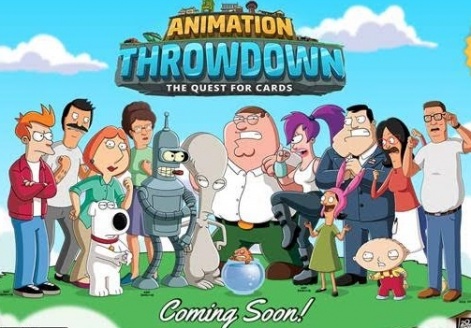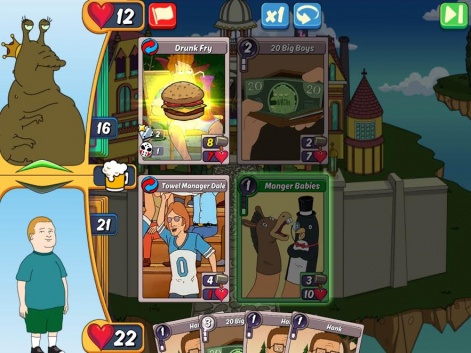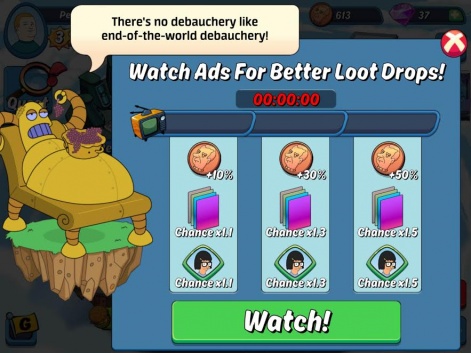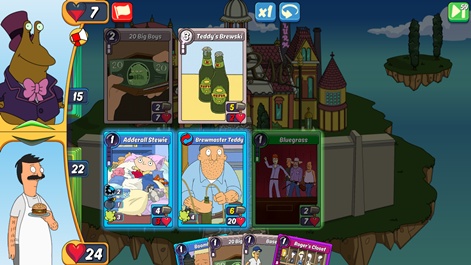It came as a surprise back in June when Fox and Kongregate announced they were teaming up for a mobile collectible card game.
Not least because of the five big-name IP it was packing in to this single game: Family Guy, American Dad, Futurama, King of the Hill and Bob's Burgers.
After a period in soft launch, the game - which was co-developed by Chicago-based Synapse Games and Chinzilla Games of San Francisco - was launched in mid-September.
But how did this melting pot of companies and well-loved properties come together and what was the development process like?
PocketGamer.biz delved behind the scenes with Kongregate's Senior Producer Peter Eykemans and Senior Director of Marketing Jeff Gurian to find out.
PocketGamer.biz: How and when did the partnership between Fox and Kongregate first come about?
Peter Eykemans: The partnership began about two years ago as a theoretical discussion between Kongregate and Fox Digital Entertainment.
Kongregate wanted to create a collectible card game incorporating licensed IP and Fox Digital Entertainment expanded upon the initial concept by including multiple shows.

To create the best possible game, Kongregate recruited two of its strongest developers, Synapse Games (Tyrant, Global Assault, Spellstone) and Chinzilla (Little Alchemist), to partner up and bring their expertise to the complex project.
Both developers added unique perspectives, expertise and game mechanics.Peter Eykemans
With Kongregate leading production, both developers added unique perspectives, expertise and game mechanics influenced by their past titles.
Was the idea always to produce a game mashing up the five shows in question? When was it proposed that this should take the form of a CCG, and how did the idea evolve?
Peter Eykemans: Animation Throwdown was a unique undertaking for both Fox Digital Entertainment and Kongregate.This was the first time they’ve incorporated this number of IPs in a single title.
We pitched the idea of it being a CCG as Kongregate’s seen great success from card games in the past with Tyrant, Little Alchemist, Spellstone, and Battehand.
So by mining the rich worlds of these five shows and bringing game mechanics that are extremely popular with our audience, we knew we had a winning combination.
To what extent were Fox Digital Entertainment and the creative stakeholders (including the shows) on hand to help make it an authentic experience?
Peter Eykemans: Every piece of art and writing passed through Fox Digital Entertainment and the shows, requiring strict approvals and oversight to ensure everything was on brand.
As the shows got a better picture of what we were creating, they got more excited about the in-game content and comedy.
In the weeks leading up to launch, show creators and producers were sending over funny new dialogue, and suggesting new animation for use in the game.
It was really cool to see that level of excitement and involvement.
A key part of the game's appeal is in the nods to classic moments from the TV shows when you combine cards. How much time did you spend making sure these were pitched correctly and did you ensure there were die-hard fans of these shows on the dev team?
Peter Eykemans: The game developers and producers spent months on end combing through season after season of each show, picking characters and moments that would blend together in order to be accessible to new fans while giving die-hard fans a shout out.
We spent months on end combing through season after season of each show.Peter Eykemans
The idea was that gameplay consistently brings a smile to your face and really digs into the worlds of the shows.
Some combinations are based on well-known classics (such as Fry + Money), others are tongue in cheek while others are geared towards the unexpected.
At the same time, any CCG lives or dies by its gameplay. How did you find the balance between humour and strategic depth, particularly for those less familiar with the genre?
Peter Eykemans: During development, we went back and forth between several styles of gameplay, finally settling on a version with very strategic decision-making around when to play a combo versus a standard card.
And by iterating constantly over months, we found a balance between early simplicity and late complexity, so the depth of the game only becomes apparent over days and weeks of playing.
How big was the team on Animation Throwdown: The Quest for Cards and how long was the total development time?
Peter Eykemans: Between the two developers and the team at Kongregate, Animation Throwdown: The Quest for Cards was, surprisingly, built by a core team of about 30 (very dedicated) people.
This included development, operations, production, marketing, artists, community and QA resources between Kongregate, Synapse and Chinzilla.

This does not include the dedicated producers and the marketing team at Fox Digital that made the game happen.
The total development time, including several months testing in international regions, was about 18 months.
About six months of that was spent being live in limited test markets to allow for game tuning and improvements based on user feedback.
The total development time was about 18 months.Peter Eykemans
We were able to test out and refine features like the battlefield combo system (allowing players to join cards while in combat) which was really popular with players and helped to increase combo uses by almost 2x.
What was the biggest challenge you overcame during development?
Peter Eykemans: The most complex part of the project was teaming up two developers, in two time zones, with the central hub of Kongregate organising what’s getting done and when.
Juggling all the teams, who generally work solo, into creating such a massive undertaking was, and still is, a complicated test of ongoing communication and organisation.
There was also the element of the five IPs. Bringing them together for the first time in a mobile game required a balance to ensure all the properties were balanced, both for the parties involved on the production side, but also for the fans who would play the game.
What was your thinking in regards to your incentivised ads, which give the player better loot drops rather than an immediate reward? Have you been pleased with how players have been engaging with them?
Peter Eykemans: Our goal with incentivised ads is to make them feel beneficial rather than a chore (or forced).
By giving players a longer term benefit rather than immediate reward, it improves the overall experience by giving the players more rewards than they would have seen with an instant gift.

It was important to have the ad experience complement the game experience and not compete with the in-game currency.
We’ve been very happy with the results and have some additional placements in mind to further reward players for engaging with ads in other game mechanics.
How important do you consider the game's PvP arena mode to be, particularly for the game's long-term retention?
Peter Eykemans: PvP is the most critical part of the game to build long-term engagement and retention.
PvP is the most critical mode to build long-term engagement and retention.Peter Eykemans
By giving players a light level of competition, and powerful, unlockable rewards (new Heroes), it’s the most rewarding element of the game to progress in.
Beyond that, we’re building out an extensive limited-time event system, where players have additional modes and battles to engage with, on top of their day-to-day adventuring.
We recognise that continual updates and events are key to making the game engaging and compelling to players for the long-term.
For a game with such strong brand recognition, how useful has the opportunity to promote the game in GameStop retail stores across the US been for user acquisition?
Jeff Gurian: From a marketing standpoint, the inclusion of the IPs has been incredibly valuable.
At a glance, players instantly recognise one or more characters in all our promotional artwork, so there’s an immediate connection.
And by tying those popular shows, to dedicated gamers - the GameStop customer - we’ve gained a batch of incredibly valuable users who are deep into the game.
Retail promotions are still ongoing and Animation Throwdown will have exposure in GameStop stores off and on for the remainder of the year.
One of the more unique promotions we’ve done was to distribute four million cards to GameStop US stores.

The cards were designed from in-game cards designs on one side, while the other side contains unique promotional codes for both iOS and Android that can be used to redeem free rare cards.
This promotion is currently ongoing and will run until all the cards are distributed to GameStop customers over the next 20 to 30 days.
Tell us about what other marketing approaches you've been taking, including cross-promotion across Kongregate's mobile portfolio.
Jeff Gurian: Animation Throwdown received huge promotional support across Kongregate and GameStop.
Animation Throwdown received huge promotional support across Kongregate and GameStop.Jeff Gurian
Channels included email, page skins, house ads, cross promotion from other Kongregate titles, and a push notice from the GameStop retail app just to name a few channels.
We will continue to promote the game across channels and develop re-engagement programs to let players know when new content has been added and when events are running.
How happy have you been with the launch? Any surprises?
Peter Eykemans: Launch has been incredible. Both Apple and Google gave the game great support on launching, helping to skyrocket our installs.
And after months of prep on the scalability and stability side, our engineers were able to keep the game up and running as millions of players entered the battlefield.
Our ratings soared on both platforms, and seeing such excitement from players really drove home the fact that our hard work was really paying off.
Any early stats/KPIs you're able to share?
Peter Eykemans: We’ve been very happy with our stats on the wave of feature traffic we’ve seen across the past month - which is generally lower than stats from targeted UA and users specifically seeking out the game in the app stores.
We’ve kept a consistent 90%+ completion rate on our tutorial across all traffic, and our D1 retention remains over 50% - even when players realise it’s a collectible card game, a genre that often scares off casual gamers.
We’ve already had over four million game installs.
What's next for Animation Throwdown?
Peter Eykemans: More content, more special events, new game modes, bigger rewards! We have a comprehensive roadmap of plans for all of the above that should keep users engaged for a long time to come.
More shows? The game can accommodate additional content and it has been discussed. As they say, ”stay tuned”.





















